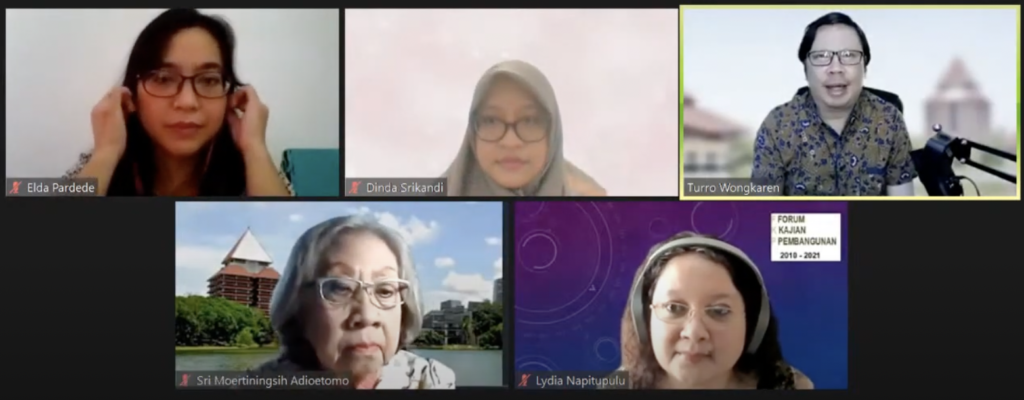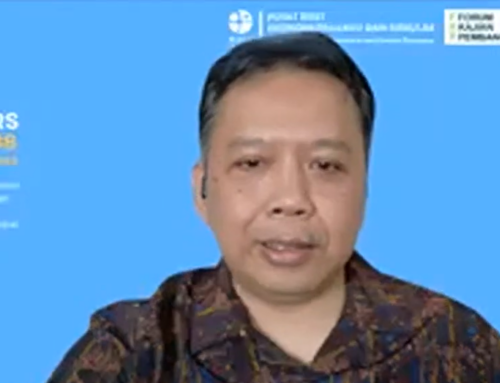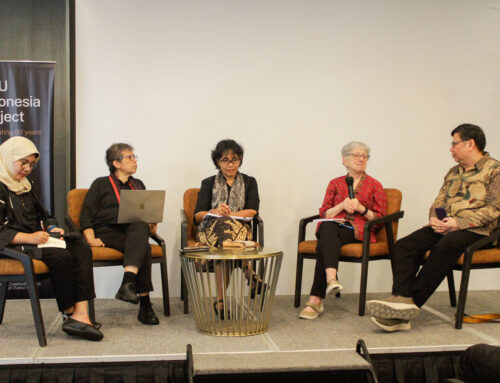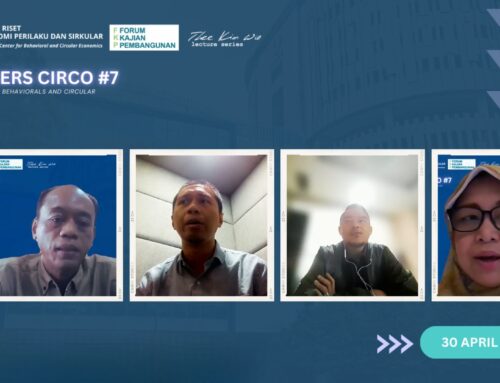FKP hosted by Lembaga Demografi FEB UI with Professor Sri Moertiningsih Adioetomo (Lembaga Demografi FEB UI) and Elda L. Pardede (Lembaga Demografi FEB UI). Thursday, 5 August 2021.
KEY POINTS:
- Currently, there are more elderly women than elderly men in Indonesia. Older men tend to be married, while older women remain widowed and live alone. Women live longer but their health-adjusted life expectancy (HALE) is shorter than men’s, and older women tend to be poorer and suffer more from disability than older men. Therefore overall, it can be said that elderly women in Indonesia are living in a worse off condition compared to elderly men. Around half of the elderly (60+) work, and the majority work in the informal sector, with older women making up a higher proportion. About 20% of older persons are working long hours (more than 49 hours a week). Most of them live in urban areas and work in the service sector.
- The pandemic hit the elderly more than the others due to their conditions that are more vulnerable. Many of them rely on transfers and during the pandemic, they receive less money. More older persons were laid off compared to younger people. Faced with a dwindling income and rising prices, older people tend to reduce the quantity and frequency of food consumption. The oldest-old, older women and elderly who live in rural areas tend to be poorer and most vulnerable. In terms of health, mobility restrictions have prevented older persons from going for check-ups and resupplying their medicine. If prolonged, this situation could increase the number of older persons who need long term care.
SUMMARY
- There is an increasing size of the elderly population in Indonesia and many provinces in Indonesia such as Yogyakarta, Bali, East and Central Java, West Sumatra, and North Sulawesi are already facing an aging population. In this webinar, Professor Sri Moertiningsih Adioetomo and Elda Pardede (both of Lembaga Demografi FEB UI) delved into the social, health, and economic trait of Indonesia’s older population, and explored the impacts of COVID-19 on this population.
- Currently, there are more elderly women than elderly men in Indonesia. Older men tend to be married, while older women remain widowed and live alone. Women live longer but their health-adjusted life expectancy (HALE) is shorter than men’s, and older women tend to be poorer and suffer more from disability than older men. Therefore overall, it can be said that elderly women in Indonesia are living in a worse off condition compared to elderly men.
- Around half of the elderly (60+) work, and the majority work in the informal sector, with older women making up a higher proportion. About 20% of older persons are working long hours (more than 49 hours a week). Most of them live in urban areas and work in the service sector. A higher proportion of working parents were laid off compared to younger employees. Higher proportions who are dismissed are in the service or social service sector (tourism, restaurants, and hotels).
- What is the situation of elderly people during the pandemic? An online survey by Statistics Indonesia (Badan Pusat Statistik/BPS) provides several insights. First, the survey found that the elderly tend to have better knowledge of the Social Distancing Policy (PSBB in March) than the younger people. Older women specifically, tend to have better knowledge of PSBB and have better compliance to the health protocols than older men. Second, in terms of wealth, older persons have a higher tendency to be poor than non-older persons and all populations. The impact of COVID- 19 tends to increase the poverty rate among the elderly. Third, the oldest-old, the older women, and the elderly who live in rural areas, tend to be poorer and most vulnerable. It is important to note, however, that only 11% of the elderly accessed the internet in 2020, therefore the survey is likely to capture the full extent of the lives of the elderly. More information is needed to have a more representative and thorough analysis.
- The Statistics of Older Persons 2020 published by BPS provide additional insight into the plight of the elderly during the pandemic. Most of the younger cohort of elderly people (the “young olds” aged 60-69 years) get their money from work. However, the older and the oldest old (70-79 and 80+ years) men and most older women (60+ years) rely on transfers. During the pandemic, older people have fewer resources, due to job loss and a decrease in the money transfer that they received. While their income is decreasing, prices are also increasing due to disruption of production and distribution, resulting in a double burden. Responding to the decrease in income and rising prices, older people reduce the quantity and frequency of food consumption. They rely more on food subsidies or other social protection such as non-cash food assistance (PKH and BPNT).
- There is also an increase in unmet needs for health services among those who suffer from non-communicable diseases (NCDs). Mobility restrictions have prevented older persons from going for check-ups and resupplying their medicine. If prolonged, this situation could increase the number of older persons who need long-term care. For instance, untreated high blood pressure may lead to a stroke which could increase the need for long-term care. Females, the oldest old, those living in rural areas, and the 40% lowest expenditure have the highest unmet need for health services. There is also an untold fear and anxiety which could lead to stress and depression which are often overlooked.
- Although almost three-quarters of older persons own social health insurance, only 23% of them are able to pay the contribution by themselves while the other 45% of them are paid by the government (PBI). However, the distribution of government-paid contributions is still problematic, many of the recipients are from the middle to high expenditure households. It is important to seriously reallocate the PBI towards the poorest.
- In conclusion, the pandemic hit the elderly more than the others due to their conditions that are more vulnerable. Older women, the oldest old, and those living in rural areas are the more vulnerable ones. Therefore, it is necessary to continue to build a system to take care of the elderly, while also taking care of the emergency measures to handle the pandemic.





